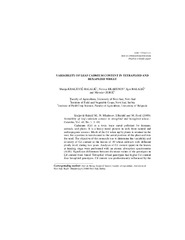Приказ основних података о документу
Variability of leaf Cadmium content in tetraploid and hexaploid wheat
Varijabilnost sadržaja kadmijuma u listovima tetraploidne i heksaploidne pšenice
| dc.creator | Kraljević-Balalić, Marija | |
| dc.creator | Mladenov, Novica | |
| dc.creator | Balalić, Igor | |
| dc.creator | Zorić, Miroslav | |
| dc.date.accessioned | 2021-04-26T18:30:27Z | |
| dc.date.available | 2021-04-26T18:30:27Z | |
| dc.date.issued | 2009 | |
| dc.identifier.issn | 0534-0012 | |
| dc.identifier.uri | http://fiver.ifvcns.rs/handle/123456789/699 | |
| dc.description.abstract | Cadmium (Cd) is a toxic trace metal pollutant for humans, animals, and plants. It is a heavy metal present in soils from natural and anthropogenic sources. Much of the Cd taken up by plants is retained in the root, but a portion is translocated to the aerial portions of the plant and into the seed. The objective of this research was to determine the variability and diversity of Cd content in the leaves of 30 wheat cultivars with different ploidy level, during two years. Analyses of Cd content (ppm) in the leaves at heading stage were performed with an atomic absorption spectrometer (AAS). Significant differences between the mean values of the genotypes in Cd content were found. Tetraploid wheat genotypes had higher Cd content than hexaploid genotypes. Cd content was predominantly influenced by the year of growing (73%). The influence of genotype on Cd content amounted 16% and the interaction genotype × year 11%. The cluster of the genotypes consists of four groups. In the groups three and four were some of the genotypes (Kalyan Sona, Partizanka and NS Rana 5) with lowest Cd content in the leaves. They could be chosen as parents in the hybridization for lower cadmium concentration. | en |
| dc.description.abstract | Kadmijum (Cd) pripada grupi 'teških metala'. On je toksičan za biljke, životinje i ljude. Njegovo prisustvo u zemljištu potiče iz prirodnih i intropogenih izvora. Veći deo usvojenog Cd zadržava se u korenu, ali deo se translocira u nadzemne delove biljke i u seme. Cilj ovog istraživanja je bio da se ispita varijabilnost i divergentnost sadržaja Cd u listovima kod 30 genotipova pšenice različitog nivoa ploidnosti. Ogled je izveden u toku dve vegetacione sezone. Sadržaj Cd (ppm) u listovima pšenice u fazi klasanja određen je primenom AAS. Ustanovljene su značajne razlike u srednjim vrednostima između ispitivanih genotipova. Tetraploidni genotipovi imali su veći sadržaj Cd u odnosu na heksapolidne. Glavni efekti (genotip i godina) i interakcija pokazali su visoko značajne razlike. Sadržaj Cd je najvećim delom bio uslovljen godinom ispitivanja (73%). Uticaj genotipa na sadržaj Cd iznosio je 16%, dok je interakcija genotip×godina iznosila 11%. Klaster genotipova sastojao se od četiri grupe. U grupi tri i četiri nalazili su se genotipovi sa najmanjim sadržajem Cd u listovima tj. najefikasniji u korišćenju Cd (Kalyan Sona, Partizanka i NS Rana 5). Oni bi se mogli koristiti kao roditelji u hibridizaciji na niži sadržaj Cd. | sr |
| dc.publisher | Društvo genetičara Srbije, Beograd | |
| dc.rights | openAccess | |
| dc.rights.uri | https://creativecommons.org/licenses/by-nc-nd/4.0/ | |
| dc.source | Genetika-Belgrade | |
| dc.subject | Cd content | en |
| dc.subject | interaction genotype x year | en |
| dc.subject | heading stage | en |
| dc.subject | variability | en |
| dc.subject | wheat | en |
| dc.title | Variability of leaf Cadmium content in tetraploid and hexaploid wheat | en |
| dc.title | Varijabilnost sadržaja kadmijuma u listovima tetraploidne i heksaploidne pšenice | sr |
| dc.type | article | |
| dc.rights.license | BY-NC-ND | |
| dc.citation.epage | 10 | |
| dc.citation.issue | 1 | |
| dc.citation.other | 41(1): 1-10 | |
| dc.citation.rank | M51 | |
| dc.citation.spage | 1 | |
| dc.citation.volume | 41 | |
| dc.identifier.doi | 10.2298/GENSR0901001K | |
| dc.identifier.fulltext | http://fiver.ifvcns.rs/bitstream/id/1545/696.pdf | |
| dc.identifier.wos | 000268916100001 | |
| dc.type.version | publishedVersion |


